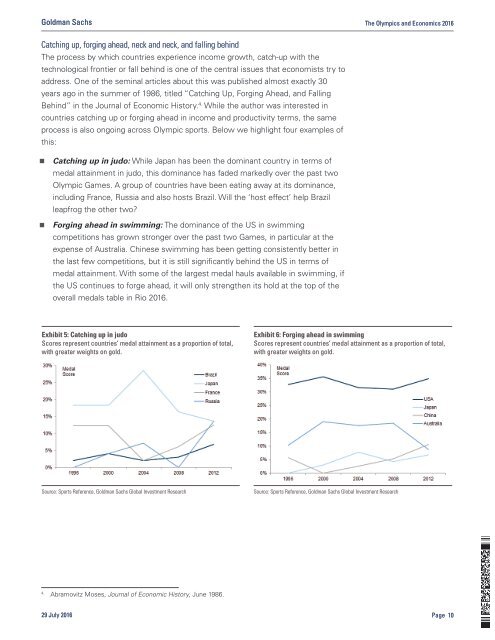You also want an ePaper? Increase the reach of your titles
YUMPU automatically turns print PDFs into web optimized ePapers that Google loves.
Goldman Sachs The Olympics and Economics 2016<br />
Catching up, forging ahead, neck and neck, and falling behind<br />
The process by which countries experience income growth, catch-up with the<br />
technological frontier or fall behind is one of the central issues that economists try to<br />
address. One of the seminal articles about this was published almost exactly 30<br />
years ago in the summer of 1986, titled “Catching Up, Forging Ahead, and Falling<br />
Behind” in the Journal of Economic History. 4. While the author was interested in<br />
countries catching up or forging ahead in income and productivity terms, the same<br />
process is also ongoing across Olympic sports. Below we highlight four examples of<br />
this:<br />
n<br />
n<br />
Catching up in judo: While Japan has been the dominant country in terms of<br />
medal attainment in judo, this dominance has faded markedly over the past two<br />
Olympic Games. A group of countries have been eating away at its dominance,<br />
including France, Russia and also hosts Brazil. Will the ‘host effect’ help Brazil<br />
leapfrog the other two?<br />
Forging ahead in swimming: The dominance of the US in swimming<br />
competitions has grown stronger over the past two Games, in particular at the<br />
expense of Australia. Chinese swimming has been getting consistently better in<br />
the last few competitions, but it is still significantly behind the US in terms of<br />
medal attainment. With some of the largest medal hauls available in swimming, if<br />
the US continues to forge ahead, it will only strengthen its hold at the top of the<br />
overall medals table in Rio 2016.<br />
Exhibit 5: Catching up in judo<br />
Scores represent countries’ medal attainment as a proportion of total,<br />
with greater weights on gold.<br />
Exhibit 6: Forging ahead in swimming<br />
Scores represent countries’ medal attainment as a proportion of total,<br />
with greater weights on gold.<br />
Source: Sports Reference, Goldman Sachs Global Investment Research<br />
Source: Sports Reference, Goldman Sachs Global Investment Research<br />
4.<br />
Abramovitz Moses, Journal of Economic History, June 1986.<br />
29 July 2016 Page 10


